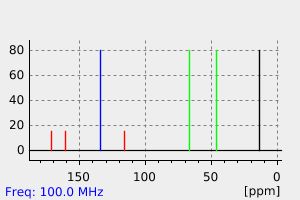2,3-dihydro-6-methyl-7H-oxazolo[3,2-a]pyrimidin-7-one | 73590-09-7
中文名称
——
中文别名
——
英文名称
2,3-dihydro-6-methyl-7H-oxazolo[3,2-a]pyrimidin-7-one
英文别名
7H-oxazolo[3,2-a]pyrimidin-7-one, 2,3-dihydro-6-methyl-;6-methyl-2,3-dihydro-[1,3]oxazolo[3,2-a]pyrimidin-7-one
CAS
73590-09-7
化学式
C7H8N2O2
mdl
——
分子量
152.153
InChiKey
OPBBMDKOBAUNPJ-UHFFFAOYSA-N
BEILSTEIN
——
EINECS
——
-
物化性质
-
计算性质
-
ADMET
-
安全信息
-
SDS
-
制备方法与用途
-
上下游信息
-
文献信息
-
表征谱图
-
同类化合物
-
相关功能分类
-
相关结构分类
计算性质
-
辛醇/水分配系数(LogP):0
-
重原子数:11
-
可旋转键数:0
-
环数:2.0
-
sp3杂化的碳原子比例:0.43
-
拓扑面积:41.9
-
氢给体数:0
-
氢受体数:2
反应信息
-
作为反应物:描述:2,3-dihydro-6-methyl-7H-oxazolo[3,2-a]pyrimidin-7-one 在 palladium on activated charcoal 叠氮基三甲基硅烷 、 四丁基氟化铵 、 氢气 作用下, 以 四氢呋喃 、 甲醇 为溶剂, 反应 2.5h, 生成 1-(2-氨基乙基)-5-甲基嘧啶-2,4-二酮参考文献:名称:Alkylation of thymine with 1,2-dibromoethane摘要:Alkylation of thymine with 1,2-dibromoethane depends strongly on the reaction conditions. Various alkyl derivatives may be produced, including N-1- or N-5-monosubstituted alkylthymines and products of their cyclisation, as well higher molecular weight products resulting from intermolecular substitution of N-1- and N-3-mono- and N-1,N-3-dialkylthymines. We have identified two cyclic products 5 and 6 and the dialkylated derivative 7, for which detailed structural analyses have been performed. (C) 2001 Elsevier Science Ltd. All rights reserved.DOI:10.1016/s0040-4020(01)00277-0
-
作为产物:描述:1,2-二溴乙烷 、 胸腺嘧啶 在 potassium tert-butylate 作用下, 以 N,N-二甲基甲酰胺 为溶剂, 反应 40.0h, 以15%的产率得到2,3-dihydro-6-methyl-7H-oxazolo[3,2-a]pyrimidin-7-one参考文献:名称:NMR and UV Study of 1,1′-(α,ω-Alkanediyl)bis[thymine] and 1,1′-(α,ω-Alkanediyl)bis[uracil]摘要:将胸腺嘧啶或尿嘧啶与Br(CH2)nBr(n = 3—10)在t-BuOK存在下处理,得到了1,1′-(α,ω-烷烃二基)双[胸腺嘧啶]或1,1′-(α,ω-烷烃二基)双[尿嘧啶],以及1-(ω-溴烷基)胸腺嘧啶或1-(ω-溴烷基)尿嘧啶。这些产物的结构是基于尿嘧啶环中5位和3位之间的耦合常数在1H NMR光谱上的分析来确定的。基于它们的1H NMR和紫外光谱,研究了这些化合物在水溶液中胸腺嘧啶和尿嘧啶环的分子聚集情况。观察到由较短的聚亚 methylene 链(如三亚甲基和四亚甲基基团)连接的两个胸腺嘧啶环之间存在堆叠相互作用。DOI:10.1246/bcsj.70.2239
表征谱图
-
氢谱1HNMR
-
质谱MS
-
碳谱13CNMR
-
红外IR
-
拉曼Raman
-
峰位数据
-
峰位匹配
-
表征信息
同类化合物
(S)-3-(2-(二氟甲基)吡啶-4-基)-7-氟-3-(3-(嘧啶-5-基)苯基)-3H-异吲哚-1-胺
(6-羟基嘧啶-4-基)乙酸
(4,5-二甲氧基-1,2,3,6-四氢哒嗪)
鲁匹替丁
马西替坦杂质7
马西替坦杂质4
马西替坦杂质
马西替坦原料药杂质D
马西替坦原料药杂质B
马西替坦
顺式-4-{[5-溴-2-(2,5-二甲基-1H-吡咯-1-基)-6-甲基嘧啶-4-基]氨基}环己醇
非沙比妥
非巴氨酯
非尼啶醇
青鲜素钾盐
雷特格韦钾盐
雷特格韦相关化合物E(USP)
雷特格韦杂质8
雷特格韦EP杂质H
雷特格韦-RT9
雷特格韦
阿西莫司杂质3
阿西莫司
阿脲四水合物
阿脲一水合物
阿维霉素
阿米美啶
阿米洛利
阿米妥钠
阿洛巴比妥
阿普瑞西他滨
阿普比妥
阿巴卡韦相关化合物B(USP)
阿卡明
阿伐那非杂质V
阿伐那非杂质1
阿伐那非杂质
阿伐那非中间体
阿伐那非
铂(2+)二氯化6-甲基-1,3-二{2-[(2-甲基丙基)硫烷基]乙基}嘧啶-2,4(1H,3H)-二酮(1:1)
钴1,2,3,6-四氢-2,6-二氧代嘧啶-4-羧酸酯(1:2)
钠5-烯丙基-4,6-二氧代-1,4,5,6-四氢-2-嘧啶醇酸酯
钠5-乙基-4,6-二氧代-1,4,5,6-四氢-2-嘧啶醇酸酯
钠5-(2-溴丙-2-烯基)-5-丁烷-2-基-4,6-二氧代-1H-嘧啶-2-醇
醌肟腙
酒石酸噻吩嘧啶
那可比妥
辛基2,6-二氧代-1,2,3,6-四氢-4-嘧啶羧酸酯
赛乐西帕杂质3
赛乐西帕KSM3







